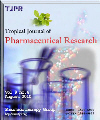
|
Tropical Journal of Pharmaceutical Research
Pharmacotherapy Group, Faculty of Pharmacy, University of Benin, Benin City, Nigeria
ISSN: 1596-5996
EISSN: 1596-5996
Vol. 8, No. 5, 2009, pp. 425-432
|
 Bioline Code: pr09055
Bioline Code: pr09055
Full paper language: English
Document type: Research Article
Document available free of charge
|
|
|
Tropical Journal of Pharmaceutical Research, Vol. 8, No. 5, 2009, pp. 425-432
| en |
Effect of Hydroxypropyl Methylcellulose and Ethyl Cellulose Content on Release Profile and Kinetics of Diltiazem HCl from Matrices
Enayatifard, R.; Saeedi, M.; Akbari, J. & Tabatabaee, Y. Haeri
Abstract
Purpose: To develop a oral controlled matrix drug delivery system for a highly water soluble drug,
diltiazem HCl, and investigate its drug release mechanism.
Method:
Diltiazem HCl was chosen because of its high water solubility. Tablets containing the drug
were prepared by direct compression method using different matrix ratios of ethyl cellulose (EC) and
hydroxypropyl methylcellulose (HPMC). The formulations were evaluated in vitro for their dissolution
characteristics over a period of 8 h. Drug release was analysed according to various release kinetic
models.
Results:
The results showed that these polymers slowed down the release of diltiazem HCl from the
matrices. In the presence of EC, increasing the concentration of HPMC decreased the release rate of
diltiazem. Furthermore, incorporation of EC in tablets with HPMC as the matrix was found to control
drug release. Kinetic analysis showed that drug release from three of the formulations was adequately
described by zero order model.
Conclusion:
The formulations developed could potentially be used for controlled delivery of highly
soluble drugs such as diltiazem HCl.
Keywords
Matrix tablets; Diltiazem HCl; Hydroxypropyl methylcellulose; Ethylcellulose; Drug release
|
| |
© Copyright © Pharmacotherapy Group, Faculty of Pharmacy, University of Benin, Benin City, 300001 Nigeria.
Alternative site location: http://www.tjpr.org
|
|
